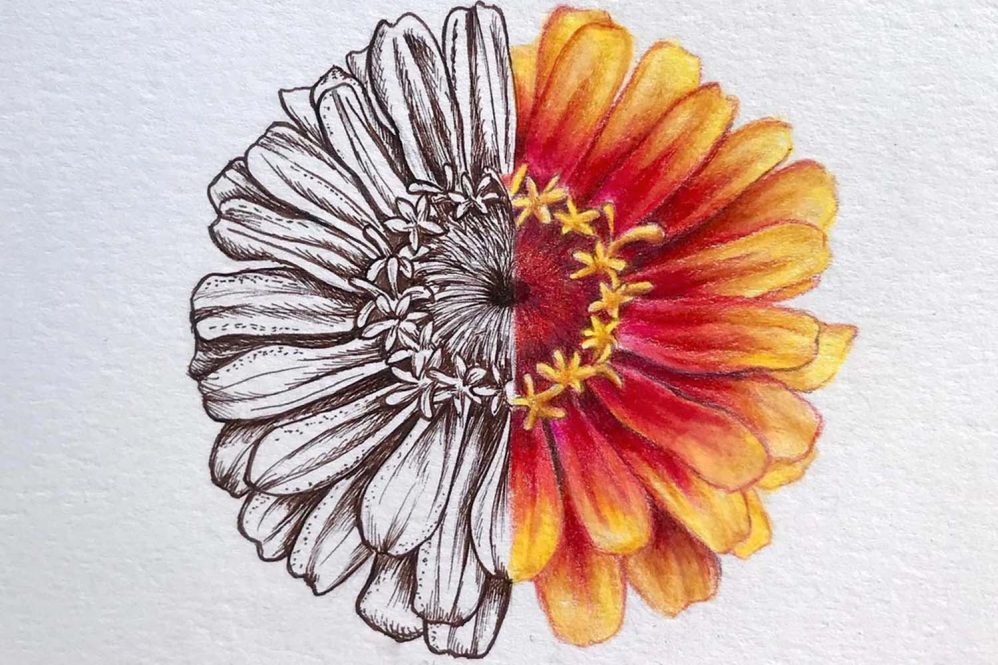When Yamini Pant ’23 (CLAS) takes notes in class, she’s the first to admit they’re not pretty; sometimes, they’re barely legible. But when she rewrites them, often they become things of beauty.
“I’ve always been interested in art,” she says. “Science is something I got more into in high school and college, and only recently I thought to start combining those two interests. I work in all different mediums: drawing, painting, digital, crafts, and clay. I’ve also recently gotten into crochet.”
No one should be surprised then by her page of notes for PSYC 2201, Drugs and Behavior. It features shades of blue and pink to color-code, and different fonts from handwritten print to bubble and cursive to categorize, along with a sketch of a neuron to point out the locations of receptive and transmitting poles.
Pant is a psychological sciences major who’s learned through the years that when she arranges classroom information into something that’s aesthetically pleasing, the information is imprinted better and stays at the forefront of her mind longer.
“I have to make sure I know my stuff and make sure everything is accurate,” she says. “Because I have such an interest in art already, making notes look nice motivates me to study better. Then, at the end of studying, it’s rewarding to see what I’ve created. It makes studying a creative process.”
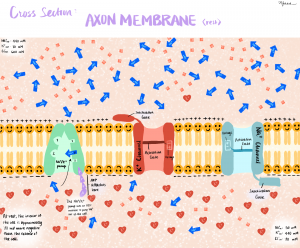
Pant and a group of other science-minded-but-art-inspired students run the UConn Sci-Art Gallery, which seeks submissions that turn the facts and figures of STEM topics into art – or, plainly, something that exemplifies the creativity that science requires.
A while back, Angela Su ’22 (PHR), ’24 Pharm.D. says she saw a model of a lung in an anatomy lab and took a picture of it, paying attention to the blues and reds that delineate veins and arteries. She’s inspired now to use tissue paper to sculpt lung tissue.
“I love crafting creative things and what’s better than putting that with science,” Su says. “I’ve always had a lot of ideas and it’s been nice having this club to give me motivation now. Coming up with ideas, even with little puns, helps me study. It makes me go through and know my notes, rather than just glance them over and blank on the test. Now, I can think back to why I put this element in this color or this drug class in this color and answer more effectively.”
The gallery, which also is on Instagram, features factual notes and study aids for things like muscle histology, DNA nucleotide problems, and anterior cut heart anatomy. It also has a gallery of submissions that use science as the subject but may portray it more creatively, and maybe not entirely lifelike.
In one piece, Coma Cocktail, Su says she was inspired by common interventions for comatose patients of unknown cause in emergency medicine – otherwise known as a “coma cocktail.” In it, Su drew a margarita with dextrose as a rim of sugar, thiamine as the liquid, oxygenation as a straw, and a naloxone nasal spray as garnish.
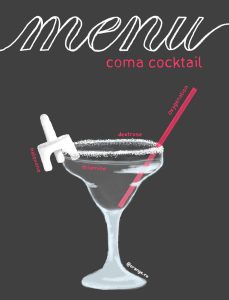
It’s the first science-specific piece of art she ever made, she says.
Considering the Whole Person
“I’ve always been uncomfortable with this idea that we separate people into disciplines,” says Thomas Abbott, an associate professor-in-residence in molecular and cell biology and founder of the UConn Sci-Art Gallery. “I always thought people are much more holistic than that as human beings. I understand the necessity of this division, but I also think it’s a mistake because we are a total package, not just art or music or science.”
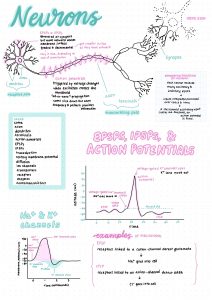
Abbott says that throughout his career he’s seen many students’ notes, oftentimes after the first exam of the semester when they didn’t score as high as they’d hoped and want to explain how hard they’re working. Many times, he’s seen drawings that not only were informative, but oftentimes beautiful.
Then, years ago, when three-ring binders still were the way students kept notes, a music major who’d struggled at the beginning of the semester in BIOL 1107, Principles of Biology, followed up at the end to give Abbott some advice: Tell your students that if they, too, are having a hard time understanding the material, draw the molecular processes and label them. He showed Abbott a binder full of gorgeous drawings.
“It got me thinking that this would be another avenue for these students,” Abbott says. “Maybe they have this additional passion or interest that no one even knew about, and because they’re siloed into this discipline or that one, they can’t break into these other areas. I thought a science art gallery would be an informal way to show the world their passion, expression, and humanity.”
In 2021, two students, Mehreen Pasha ’22 (CLAS), ’26 MD and Siddhe Patel ’22 (CLAS), agreed to help him bring the idea to life, he says. With a few other recruited students, they came up with the logo, two categories of study aids and gallery, and developed it into an independent study through the molecular and cell biology department.
Just as word began to spread last spring, Pasha and Patel graduated. This semester Pant, Su, and three others took the helm.
“Science and art are so often thought of as separate worlds, but science is such a creative field and it’s so beautiful. We don’t often get to see the magnified beauty of what science explores,” Pant says.
To gain more attention, the group has begun to issue monthly challenges to Instagram followers, in December asking, “Ever feel like something in science looks like food? Share your real science, unreal food combos.” “Notevember” called for science notes, “Inktober” sought submissions in ink, and September wanted mnemonic devices.
Abbott says that in time, he hopes there will be enough submissions to group them by class and offer them to future students for study and appreciation.
Until then, they’re seeking student submissions from any major or corner of the University. They’re also engaging Instagram followers by posting pictures of science notes spotted around campus – for instance, a whiteboard detailing cellular respiration – and asking where it might be – believe it or not, in the bookstore.
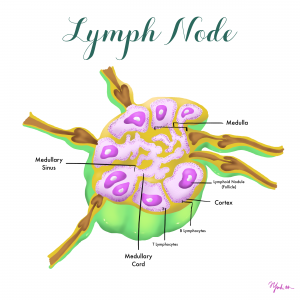
No one guessed correctly three weeks ago that two whiteboards filled with complicated algebraic equations were in, gulp, the Music Building, and not a whole note was to be found among the square roots and exponentials.
Pant says, “Whenever I go out to study, I’m always noticing people who’ve left up their study notes on whiteboards. It’s so fun to see those artistic, or aesthetically pleasing notes, in the wild. It’s also fun to see this is something that people do just naturally, because it’s a good way to study.”
